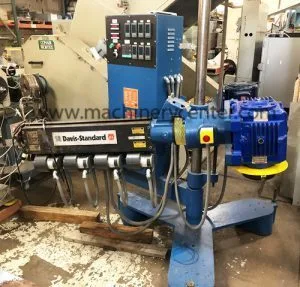Extrusion Molding Machines Guide
This extrusion molding machines guide will help explain the extrusion molding process so as to give you an good understanding for how it works.
Extrusion molding machines for plastic are used to create plastic objects with a fixed cross-sectional profile. A single screw extrusion molding machine has a rotating screw within a heated barrel. Plastic pellets are fed in through the hopper, and the friction of the rotating screw in addition to the heating elements melts the plastic as it is pushed forward and eventually exits in a unique shape through the die on the other end.
Different types of downstream components may be added to create an extrusion that fits your needs. These include water baths for cooling, puller, cutters, pelletizers for forming plastic pellets of uniform size and shape, etc.
Extrusion molding machines use a less expensive process than other processes and provides a wide variety of barriers and features such as handles although the accuracy is not as well controlled. Some materials are difficult to extrude due to their low melt viscosities although polypropylene and polyester copolymers can be extruded without issue. The parison is extruded through an die. The thickness of the parison is controlled in the die by varying the wall thickness of the parison leaving the outside diameter the same. This is made possible by having a conical inner sleeve, which can be moved up and down in the die, resulting in a controlled variation in wall thickness of the parison.
From Wikipedia, “Extrusion molding is a manufacturing process used to make pipes, hoses, drinking straws, curtain tracks, rods, and fibre. The granules melt into a liquid which is forced through a die, forming a long ‘tube like’ shape. The shape of the die determines the shape of the tube. The extrusion is then cooled and forms a solid shape. The tube may be printed upon, and cut at equal intervals. The pieces may be rolled for storage or packed together. Shapes that can result from extrusion include T-sections, U-sections, square sections, I-sections, L-sections and circular sections. One of the most famous products of extrusion molding is the optical fiber cable. ”

Extrusion is similar to injection molding except that a long continuous shape is produced.
Injection Molding Machine
is one of the most popular methods in that it mold plastics used to form 3D shapes. It uses the method of molten die casting and consists of the clamping unit and the injection unit.
Advantages
The advantages of this process are:
- Makes three-dimensional objects.
- It minimized waste and can recycle material.
- Can create detailed features and complex geometry.
- It strengthens the part after it has been molded.
- It have the ability to use different plastic types simultaneously.
Extrusion Molding Machines
uses the technique to extrude which forces out materials through a die to create shapes.This method is used to form 2D shapes.
Advantages
Some of the advantages of the extrusion process are:
- Low tool and die cost
- Fast production rates
- It can shape hard and brittle materials.
- It creates a smooth finish on the end product.
- You can make modifications to the product after it has been removed from the extruder.
- Very complex shapes can be produced with varying textures, thickness, and colors.
- Handles can be incorporated in the design

Maintaining the Proper Temperature
Maintaining the proper temperature level and melting rate of the resin is a very important consideration when creating plastic extrusions. Optimal temperature maximizes uniform fluidity of the plastic and minimizes the possibility for stress and warping of the final product. Variables such as pressure and friction that can build up in the barrel of the extruder with the result that temperatures are not constant. Heaters must be monitored, lowered, raised, or shutoff as necessary to maintain constant heat within the extruder. Also cooling fans and heater jackets can also help maintain proper extrusion temperature.
Types of Plastic Extrusion Processes
Common extrusion processes include:
- Blown Film Extrusion: Used to make plastic film products such as grocery and food storage bags. The dies in this process feature an upright, cylindrical design that pulls the molten plastic upward as it forms and cools.
- Coextrusion: Several layers of material are extruded at the same time. Two or more extruders feed different types of plastic into a single extrusion head.
- Overjacketing: is employed to coat an item in protective plastic coating. Exterior wire and cable jacketing is the most common application of overjacketing.
- Tubing Extrusion: Similar to traditional extrusion, except the die includes interior pins or mandrels to facilitate the production of hollow plastic materials.
The hope you have enjoyed this Extrusion molding machines guide and that it will help you to make an informed decision on you next purchase or at least this article has improved your understanding.
Machinery Center offers many types and sizes of extrusion molding machines to create any type of extruded product with any unique profile you may require.
We strive to offer a variety of extruders with different specifications; so whether you need an air-cooled or water-cooled barrel, temperature readouts, pressure sensors, tachometers, or other readouts for fine-tuning your individual process, or other desired characteristics, we have the equipment to match your needs.
